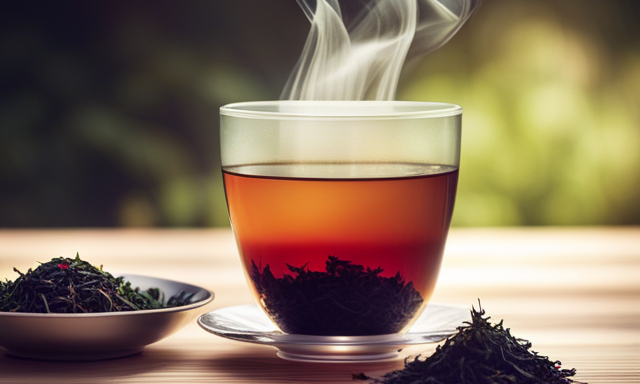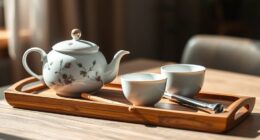When it comes to tea, there are countless options to choose from. However, if you’re looking for a cup that packs a punch, oolong tea is the way to go. This unique beverage has a distinct flavor and a strength that sets it apart from other teas.
But what makes oolong tea so strong? In this article, I will delve into the fascinating world of oolong tea and explore the factors that contribute to its robustness. From the processing method to the influence of terroir, we will uncover the secrets behind oolong tea’s strength.
We will also discuss the role of oxidation in its flavor profile and the art of brewing the perfect cup. Additionally, we will explore the impact of oolong tea on mental well-being and digestive health.
Get ready to discover the wonders of oolong tea and why it’s the ultimate choice for those seeking a stronger brew.
Key Takeaways
- Adjusting water temperature and steeping time can enhance the flavor extraction of oolong tea.
- Different teaware, such as porcelain, Yixing Clay, glass, and cast iron, can enhance the flavor and brewing experience of oolong tea.
- Multiple infusions of oolong tea can result in evolving flavors and aromas with each infusion.
- Oolong tea offers various health benefits, including boosting metabolism, regulating blood sugar levels, improving blood vessel function, providing anti-inflammatory properties, and contributing to mental alertness.
The Unique Processing Method of Oolong Tea
If you’re curious about why oolong tea is stronger, let me tell you about its unique processing method that sets it apart from other teas.
Oolong tea undergoes specific processing techniques that contribute to its robust flavor profile. The leaves are partially oxidized, which means they are exposed to oxygen for a shorter period compared to black tea but longer than green tea. This oxidation process gives oolong tea its distinct characteristics, resulting in a complex and rich taste.
The leaves are then rolled and shaped, allowing them to retain their essential oils and flavors. As a result, oolong tea exhibits a wide range of flavor profiles, from floral and fruity to nutty and toasty.
Now, let’s explore the different varieties of oolong tea and discover their unique qualities.
Varieties of Oolong Tea
With its wide range of flavors and aromas, the various types of oolong offer a delightful experience for tea connoisseurs. Oolong tea varieties can vary greatly in taste and appearance, making it a versatile and intriguing beverage.
Here are four popular oolong tea flavors to explore:
-
Floral: Oolong teas with floral notes, such as jasmine or orchid, create a delicate and fragrant brew.
-
Fruity: Some oolong teas exhibit fruity flavors like peach, apple, or citrus, adding a refreshing and vibrant twist to each sip.
-
Roasted: Oolongs that are roasted have a unique toasty and nutty character, reminiscent of caramel or roasted grains.
-
Herbal: Certain oolong teas incorporate herbal elements like ginseng or licorice, providing a soothing and earthy experience.
These variations in oolong tea flavors are influenced by factors like oxidation level, processing techniques, and the specific tea plant cultivars used.
Now, let’s delve into the influence of terroir on oolong tea.
The Influence of Terroir on Oolong Tea
When it comes to the influence of terroir on oolong tea, there are three key factors to consider: soil composition and nutrient levels, climate and weather patterns, and altitude and sunlight exposure.
The soil composition and nutrient levels play a crucial role in determining the flavor and quality of the tea.
The climate and weather patterns, including temperature, rainfall, and humidity, greatly impact the growth and development of the tea leaves.
Additionally, the altitude and sunlight exposure contribute to the unique characteristics of oolong tea, as they affect the plant’s metabolism and the formation of aromatic compounds.
Soil Composition and Nutrient Levels
To understand why oolong tea is stronger, you need to consider the soil composition and nutrient levels. The soil fertility plays a crucial role in determining the quality and flavor of the tea leaves. Oolong tea thrives in nutrient-rich soil that provides essential elements for growth and development. The micronutrient availability in the soil, such as iron, magnesium, and zinc, contributes to the robustness and complexity of the tea’s taste.
In the realm of oolong tea, soil composition is like a symphony of flavors, with each element adding its unique note to the final product. The rich, well-drained soil gives the tea leaves a depth and intensity that is unmatched. Additionally, the nutrient levels in the soil ensure that the tea plants receive the necessary nourishment to produce leaves with concentrated flavors and aroma.
To truly appreciate the strength of oolong tea, one must understand the intricate dance between soil fertility and micronutrient availability. It is through this delicate balance that oolong tea achieves its distinctive potency and character.
Now, let’s delve into the next aspect that influences the strength of oolong tea: climate and weather patterns.
Climate and Weather Patterns
If you truly want to understand the essence of a remarkable oolong, consider the impact of the climate and weather patterns on its flavor profile.
The rainfall patterns and overall climate conditions in which the tea plants are grown play a crucial role in the development of the leaves and their subsequent taste. Oolong tea is often cultivated in regions with specific climatic characteristics, such as moderate temperatures and well-distributed rainfall. These conditions allow the tea plants to grow slowly and steadily, resulting in a more complex and robust flavor.
However, with the increasing impact of climate change, there is a growing concern about the alteration of rainfall patterns and extreme weather events, which could potentially affect the quality and taste of oolong tea.
Transitioning to the next section about ‘altitude and sunlight exposure,’ the intensity of these factors further contributes to the distinctive characteristics of this exquisite tea.
Altitude and Sunlight Exposure
Immerse yourself in the world of oolong and discover how altitude and sunlight exposure contribute to the unique flavors and characteristics of this extraordinary brew. Altitude plays a crucial role in oolong tea production, as it affects the growth and development of the tea leaves. Higher altitudes, such as those found in the mountains, result in slower leaf growth and increased concentration of flavor compounds. This leads to a more robust and complex taste profile in oolong teas grown at higher elevations. Additionally, sunlight exposure influences the tea leaves’ ability to produce certain compounds, such as catechins and amino acids, which contribute to the tea’s flavor and aroma. The amount of sunlight the leaves receive throughout the day affects the balance of these compounds, ultimately shaping the taste of the final product. Understanding the impact of altitude and sunlight exposure on oolong teas allows us to appreciate the intricate flavors and nuances that make each cup truly remarkable. As we explore further, we delve into the role of oxidation in oolong tea flavor.
The Role of Oxidation in Oolong Tea Flavor
Oolong tea’s strong flavor is a result of the oxidation process. This crucial step in tea production plays a significant role in flavor development. Here are four key aspects to consider when it comes to the oxidation of oolong tea:
-
Degree of oxidation: The level of oxidation determines the tea’s flavor profile, ranging from light and floral to robust and fruity.
-
Timing: Oxidation is carefully controlled and halted at specific moments during the tea processing, ensuring the desired flavor is achieved.
-
Leaf manipulation: Tea leaves are bruised or rolled to promote oxidation, allowing the enzymes to react with oxygen and create unique flavors.
-
Artistry: The oxidation process is an art form, guided by the expertise of tea masters who understand the delicate balance of time and technique required to produce exceptional oolong teas.
Understanding the role of oxidation sets the foundation for exploring the art of brewing oolong tea.
The Art of Brewing Oolong Tea
When it comes to brewing Oolong tea, there are a few key factors to consider.
Firstly, the water temperature and steeping time play a crucial role in extracting the desired flavors. I always make sure to use water that is around 185-195°F and steep the tea for about 3-5 minutes to achieve the perfect balance.
Secondly, choosing the right teaware can greatly enhance the brewing process. I prefer using a Yixing clay teapot, as it allows the tea to steep evenly and develops a rich, complex flavor.
Lastly, Oolong tea is known for its ability to be steeped multiple times, and this is where the true magic happens. Each infusion brings out different flavors and nuances, so I always make sure to savor every cup for the optimal flavor extraction.
Water Temperature and Steeping Time
To achieve a stronger flavor in your oolong tea, adjusting the water temperature and steeping time can make all the difference. Different techniques can bring out different flavor profiles when brewing oolong tea. The water temperature plays a crucial role in extracting the desired flavors from the tea leaves. For a stronger brew, it is recommended to use water around 195°F (90°C), just below boiling point.
Steeping time also affects the strength of the tea. Longer steeping times, typically around 3-5 minutes, allow for more flavor extraction. However, be cautious not to oversteep the tea, as it can result in a bitter taste.
By understanding these brewing techniques and adjusting the water temperature and steeping time accordingly, you can enhance the strength and richness of your oolong tea.
Now, let’s move on to choosing the right teaware for the perfect tea experience.
Choosing the Right Teaware
Enhance your oolong tea experience by selecting the perfect teaware to complement the flavors and create a sensory journey. The right teaware can make all the difference in your tea-drinking ritual.
Here are some teaware options to consider:
-
Porcelain: Delicate and elegant, porcelain teaware allows the tea’s flavors to shine through.
-
Yixing Clay: Known for its porous nature, Yixing clay teapots absorb the tea’s essence over time, enhancing the flavor with each use.
-
Glass: Transparent and modern, glass teaware allows you to appreciate the tea’s color and movement as it steeps.
-
Cast Iron: Durable and traditional, cast iron teapots distribute heat evenly, offering a unique brewing experience.
-
Gaiwan: A versatile and classic option, the gaiwan allows for multiple infusions, unlocking different layers of flavor.
By choosing the right teaware, you can elevate your oolong tea experience and extract the optimal flavors through multiple infusions.
Multiple Infusions for Optimal Flavor Extraction
Experience the rich and layered flavors of oolong tea by unlocking its full potential through the art of multiple infusions.
To truly appreciate the complexities of oolong tea, it is important to understand flavor extraction techniques and utilize the right brewing equipment.
By steeping the leaves multiple times, you allow the flavors to evolve and develop, resulting in a more nuanced and satisfying cup of tea.
Each infusion brings out different flavors and aromas, creating a truly unique experience with every sip.
To achieve optimal flavor extraction, it is crucial to use high-quality loose leaf oolong tea and adjust the brewing time and temperature with each infusion.
By exploring the different infusions, you can fully appreciate the depth and intricacies of oolong tea.
Now, let’s delve into the health benefits of oolong tea.
Health Benefits of Oolong Tea
Feel the invigorating effects of oolong tea on your health as it boosts your metabolism and aids in weight management. Oolong tea has gained popularity as a natural remedy for weight loss. It enhances fat burning and increases calorie expenditure. Its unique blend of antioxidants and polyphenols helps regulate blood sugar levels, reducing the risk of developing heart diseases.
Oolong tea promotes heart health by improving blood vessel function and reducing bad cholesterol levels. Additionally, its high concentration of catechins provides anti-inflammatory properties, protecting against chronic diseases.
As we transition to the next section, it’s important to note that oolong tea’s health benefits are not solely attributed to its antioxidants and polyphenols. Its caffeine content also plays a role.
Oolong Tea and Caffeine Content
Get ready to be blown away by the incredible jolt of energy and alertness that comes from the caffeine content in a cup of oolong tea! Oolong tea is known for its moderate caffeine content, which can give you a gentle pick-me-up without the jitters or crash that can come from other caffeinated beverages.
Here are five reasons why oolong tea is a great choice for boosting your energy levels:
- Oolong tea can aid in weight loss by increasing metabolism and promoting fat burning.
- It helps support heart health by reducing cholesterol levels and lowering blood pressure.
- Oolong tea contains antioxidants that can protect against free radicals and inflammation.
- It can improve digestion and promote a healthy gut.
- Oolong tea has been found to enhance mental alertness and improve cognitive function.
With all these incredible benefits, it’s no wonder that oolong tea is a favorite among tea enthusiasts. Speaking of mental well-being, let’s dive into the next section about oolong tea and its positive effects on our mind.
Oolong Tea and Mental Well-being
Improve your mental well-being by incorporating oolong tea into your daily routine. Oolong tea has been known to provide stress relief and promote better sleep quality. The unique combination of caffeine and amino acids in oolong tea helps to calm the mind and reduce anxiety.
The tea’s soothing aroma and smooth taste create a sense of relaxation, making it the perfect beverage to enjoy after a long day. Additionally, oolong tea contains theanine, an amino acid that promotes relaxation and improves sleep quality.
By incorporating oolong tea into your daily routine, you can experience the benefits of reduced stress and improved sleep, leading to better mental well-being.
Transitioning into the subsequent section about oolong tea and digestive health, this aromatic tea can also aid in maintaining a healthy digestive system.
Oolong Tea and Digestive Health
Enhance your digestive health and promote a well-functioning system by incorporating the aromatic oolong tea into your daily routine. Oolong tea has been known to have numerous benefits on digestion, making it an excellent choice for those looking to improve their overall gut health.
Studies have shown that oolong tea can aid in weight loss by increasing metabolism and fat oxidation. Additionally, oolong tea has been found to regulate blood sugar levels, which is crucial for maintaining a healthy digestive system. The polyphenols present in oolong tea help to regulate the release of insulin and improve insulin sensitivity.
These properties make oolong tea a valuable addition to a well-balanced diet and lifestyle. Exploring oolong tea variations and blends further allows you to personalize your tea experience and discover new flavors and combinations.
Exploring Oolong Tea Variations and Blends
Indulge in the delightful world of oolong tea variations and blends, and you’ll soon find yourself immersed in a symphony of flavors that will transport your taste buds to new heights of pleasure. Oolong tea blends offer a diverse range of unique tastes and aromas that cater to different preferences. From floral and fruity blends to smoky and earthy variations, there is an oolong tea blend for everyone. These blends combine the distinct characteristics of oolong tea with other ingredients like fruits, flowers, and herbs, creating a harmonious fusion of flavors. Additionally, oolong tea has been linked to weight loss due to its ability to boost metabolism and aid in digestion. So, not only can you enjoy the delightful flavors of oolong tea blends, but you may also reap the benefits of its potential weight loss properties.
| Blend Name | Description |
|---|---|
| Floral Fusion | A delicate blend of oolong tea with hints of jasmine and rose petals, creating a fragrant experience |
| Fruity Medley | A refreshing blend of oolong tea infused with tropical fruits, delivering a burst of fruity flavors |
| Smoky Mountain | A bold blend of oolong tea with a smoky undertone, reminiscent of campfire roasted goodness |
Frequently Asked Questions
What are the different types of oolong tea available in the market?
There are various types of oolong tea flavors available in the market, each with its unique characteristics. Some popular brands known for their quality are Tie Guan Yin, Da Hong Pao, and Ali Shan.
How does the geographical location and climate affect the taste of oolong tea?
How does the geographical location and climate affect the taste of oolong tea? The unique combination of geographical factors and climate influence the growth of tea leaves, resulting in a distinct flavor profile that varies from region to region.
Does the degree of oxidation in oolong tea impact its flavor and aroma?
The degree of oxidation in oolong tea significantly impacts its flavor and aroma. Additionally, oolong tea has been found to promote weight loss and aid digestion, making it a beneficial beverage for overall health.
What are the specific brewing techniques to bring out the best flavor in oolong tea?
Tea brewing tips for bringing out the best flavor in oolong tea include using high-quality loose leaves, steeping at the right temperature and time, and using a clay teapot. Oolong tea offers a range of flavor profiles, from floral and fruity to roasted and nutty.
Are there any specific health benefits associated with consuming oolong tea?
Oolong tea has been linked to weight loss due to its ability to boost metabolism and increase fat burning. It also promotes heart health by reducing cholesterol levels and improving blood flow.
Conclusion
In conclusion, Oolong tea is a true marvel. Its unique processing method creates a flavor profile that is stronger and more complex than any other tea.
The influence of terroir adds a distinct character to each variety, making every sip a journey of taste.
The role of oxidation cannot be underestimated, as it brings out the intricate flavors and aromas that make Oolong tea so special.
Brewing this tea is an art form, requiring precision and skill.
And let’s not forget the numerous health benefits, from promoting mental well-being to aiding in digestion.
Oolong tea is truly a beverage worth exploring, with its endless variations and blends.
It’s like a symphony of flavors in every cup, a sensation that will leave you craving for more.









